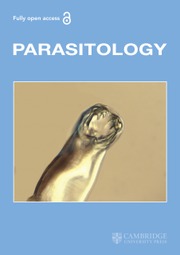Crossref Citations
This article has been cited by the following publications. This list is generated based on data provided by
Crossref.
Hoerauf, Achim
2002.
The Filaria.
Vol. 5,
Issue. ,
p.
109.
Korten, Simone
Volkmann, Lars
Saeftel, Michael
Fischer, Kerstin
Taniguchi, Masaru
Fleischer, Bernhard
and
Hoerauf, Achim
2002.
Expansion of NK Cells with Reduction of Their Inhibitory Ly-49A, Ly-49C, and Ly-49G2 Receptor-Expressing Subsets in a Murine Helminth Infection: Contribution to Parasite Control.
The Journal of Immunology,
Vol. 168,
Issue. 10,
p.
5199.
Gray, Carolyn A.
and
Lawrence, Rachel A.
2002.
Interferon‐γ and nitric oxide production are not required for the immune‐mediated clearance of Brugia malayi microfilariae in mice.
Parasite Immunology,
Vol. 24,
Issue. 6,
p.
329.
Gray, Carolyn A.
and
Lawrence, Rachel A.
2002.
A role for antibody and Fc receptor in the clearance ofBrugia malayi microfilariae.
European Journal of Immunology,
Vol. 32,
Issue. 4,
p.
1114.
Satoguina, Judith
Mempel, Martin
Larbi, John
Badusche, Marlis
Löliger, Cornelius
Adjei, Ohene
Gachelin, Gabriel
Fleischer, Bernhard
and
Hoerauf, Achim
2002.
Antigen-specific T regulatory-1 cells are associated with immunosuppression in a chronic helminth infection (onchocerciasis).
Microbes and Infection,
Vol. 4,
Issue. 13,
p.
1291.
Pfaff, Alexander W
Schulz-Key, Hartwig
Soboslay, Peter T
Taylor, David W
MacLennan, Karen
and
Hoffmann, Wolfgang H
2002.
Litomosoides sigmodontis cystatin acts as an immunomodulator during experimental filariasis.
International Journal for Parasitology,
Vol. 32,
Issue. 2,
p.
171.
Duerr, H.P.
Dietz, K.
Schulz-Key, H.
Büttner, D.W.
and
Eichner, M.
2003.
Density-dependent parasite establishment suggests infection-associated immunosuppression as an important mechanism for parasite density regulation in onchocerciasis.
Transactions of the Royal Society of Tropical Medicine and Hygiene,
Vol. 97,
Issue. 2,
p.
242.
Brattig, N.W.
2004.
Pathogenesis and host responses in human onchocerciasis: impact of Onchocerca filariae and Wolbachia endobacteria.
Microbes and Infection,
Vol. 6,
Issue. 1,
p.
113.
Maizels, Rick M.
Balic, Adam
Gomez‐Escobar, Natalia
Nair, Meera
Taylor, Matt D.
and
Allen, Judith E.
2004.
Helminth parasites – masters of regulation.
Immunological Reviews,
Vol. 201,
Issue. 1,
p.
89.
Timmann, C
Fuchs, S
Thoma, C
Lepping, B
Brattig, N W
Sievertsen, J
Thye, T
Müller-Myhsok, B
and
Horstmann, R D
2004.
Promoter haplotypes of the interleukin-10 gene influence proliferation of peripheral blood cells in response to helminth antigen.
Genes & Immunity,
Vol. 5,
Issue. 4,
p.
256.
Duerr, H.P.
Dietz, K.
Schulz-Key, H.
Büttner, D.W.
and
Eichner, M.
2004.
The relationships between the burden of adult parasites, host age and the microfilarial density in human onchocerciasis.
International Journal for Parasitology,
Vol. 34,
Issue. 4,
p.
463.
PION, S. D. S.
GARDON, J.
KAMGNO, J.
GARDON-WENDEL, N.
CHIPPAUX, J. P.
and
BOUSSINESQ, M.
2004.
Structure of the microfilarial reservoir ofLoa loain the human host and its implications for monitoring the programmes of Community-Directed Treatment with Ivermectin carried out in Africa.
Parasitology,
Vol. 129,
Issue. 5,
p.
613.
Graham, Andrea L.
Taylor, Matthew D.
Le Goff, Laetitia
Lamb, Tracey J.
Magennis, Marisa
and
Allen, Judith E.
2005.
Quantitative appraisal of murine filariasis confirms host strain differences but reveals that BALB/c females are more susceptible than males to Litomosoides sigmodontis.
Microbes and Infection,
Vol. 7,
Issue. 4,
p.
612.
Marshall, Fraser A.
Grierson, Angela M.
Garside, Paul
Harnett, William
and
Harnett, Margaret M.
2005.
ES-62, an Immunomodulator Secreted by Filarial Nematodes, Suppresses Clonal Expansion and Modifies Effector Function of Heterologous Antigen-Specific T Cells In Vivo.
The Journal of Immunology,
Vol. 175,
Issue. 9,
p.
5817.
Duerr, Hans-Peter
Dietz, Klaus
and
Eichner, Martin
2005.
Determinants of the eradicability of filarial infections: a conceptual approach.
Trends in Parasitology,
Vol. 21,
Issue. 2,
p.
88.
Babayan, Simon
Attout, Tarik
Specht, Sabine
Hoerauf, Achim
Snounou, Georges
R�nia, Laurent
Korenaga, Masataka
Bain, Odile
and
Martin, Coralie
2005.
Increased early local immune responses and altered worm development in high-dose infections of mice susceptible to the filaria Litomosoides sigmodontis.
Medical Microbiology and Immunology,
Vol. 194,
Issue. 3,
p.
151.
HOERAUF, A.
SATOGUINA, J.
SAEFTEL, M.
and
SPECHT, S.
2005.
Immunomodulation by filarial nematodes.
Parasite Immunology,
Vol. 27,
Issue. 10-11,
p.
417.
Taylor, Matthew D.
Harris, Anjanette
Nair, Meera G.
Maizels, Rick M.
and
Allen, Judith E.
2006.
F4/80+ Alternatively Activated Macrophages Control CD4+ T Cell Hyporesponsiveness at Sites Peripheral to Filarial Infection.
The Journal of Immunology,
Vol. 176,
Issue. 11,
p.
6918.
Cho, Yoon Kyung
Ryang, Yong Suk
Kim, In Sik
Park, Seung Kyu
Im, Jee Aee
and
Lee, Kyu Jae
2007.
Differential immune profiles following experimental Echinostoma hortense infection in BALB/c and C3H/HeN mice.
Parasitology Research,
Vol. 100,
Issue. 5,
p.
1053.
Korten, Simone
Badusche, Marlis
Büttner, Dietrich W.
Hoerauf, Achim
Brattig, Norbert
and
Fleischer, Bernhard
2008.
Natural death of adult Onchocerca volvulus and filaricidal effects of doxycycline induce local FOXP3+/CD4+ regulatory T cells and granzyme expression.
Microbes and Infection,
Vol. 10,
Issue. 3,
p.
313.


